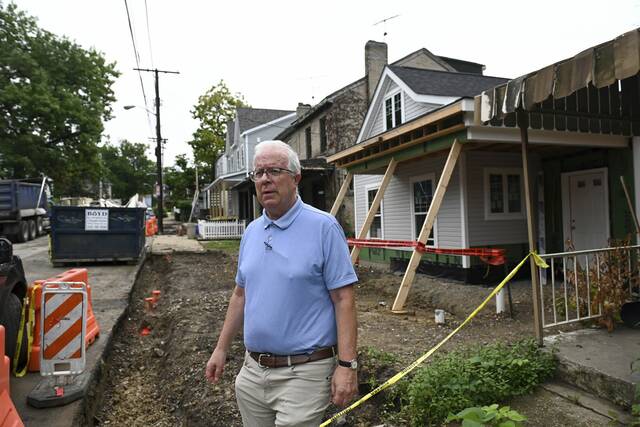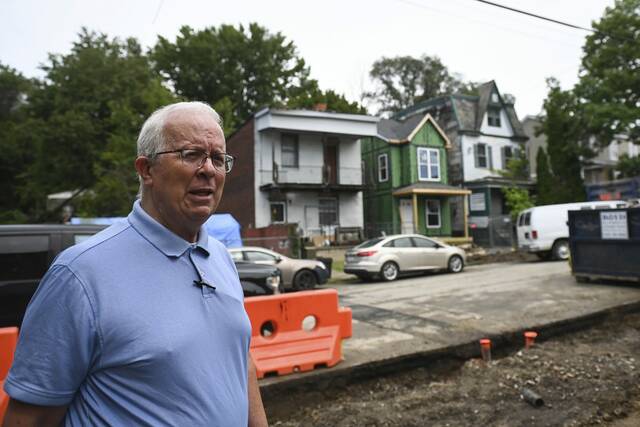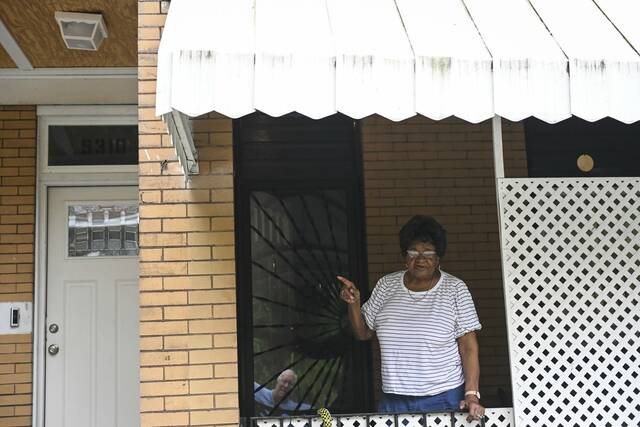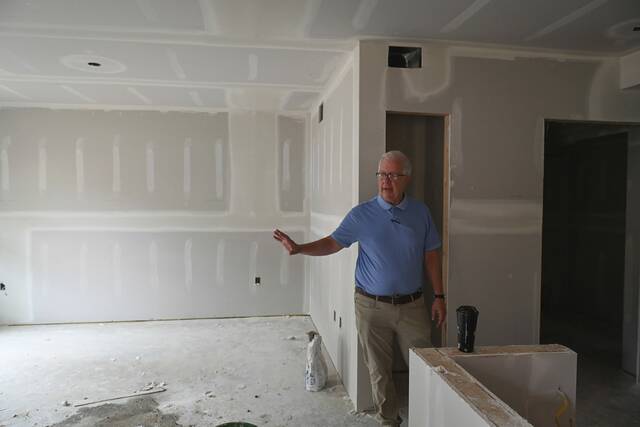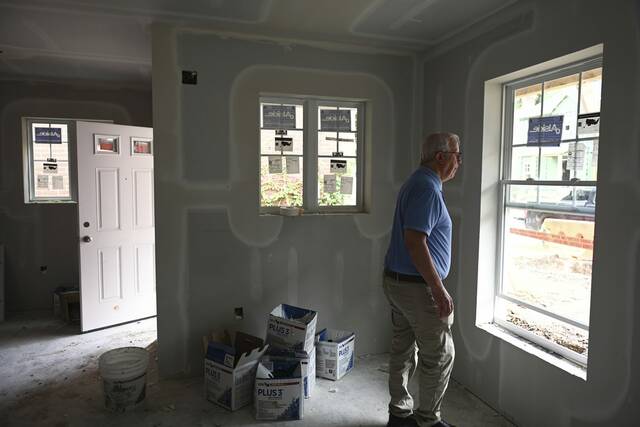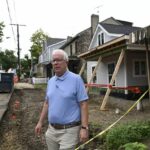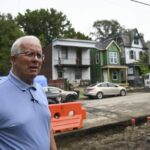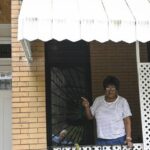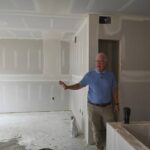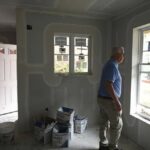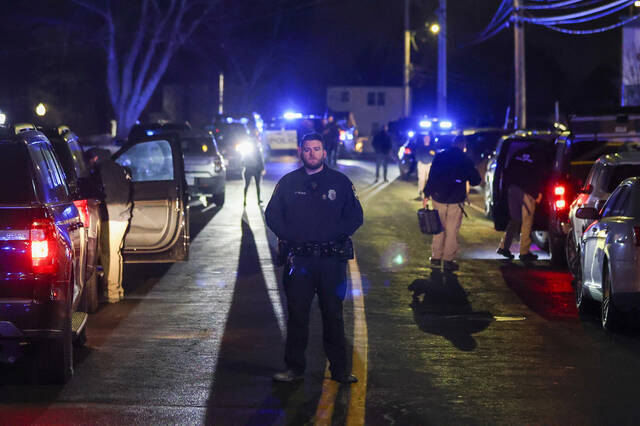Rick Swartz believes the 25 affordable houses his group is building in Garfield will help transform a neighborhood that illustrates how Pittsburgh is tackling development, blight and housing-market trends.
The Bloomfield-Garfield Corp. executive director walked through the wooden-beamed skeleton of a home under construction at 234 N. Aiken Ave., pausing before he ascended unadorned steps to the second floor. As contractors hammered on the roof above, Swartz snaked through empty rooms and envisioned their future.
“Looks like we have a bathroom here — and another one,” said Swartz, as he pointed to a room with new windows. “This is a three-bedroom, two-bath house. And the master bedroom will have its own bath.”
Rent there for a family making up to $50,000 a year will start at $985, Swartz said. Pittsburgh’s median gross rent in 2020 was $1,180, which is higher than Pennsylvania’s figure, according to the U.S. Census Bureau.
“Most people don’t want to buy or move into a neighborhood that’s skidding,” Swartz said. “We aren’t just talking about change — we’re initiating the change ourselves.
“Is Garfield going to become Mt Lebanon? The answer is no. But there’s much more of a focus on affordable housing than there ever was before.”
Transforming Garfield
Housing is transforming Garfield, a once-blighted East End Pittsburgh neighborhood where new home construction and existing market-rate sales are hitting levels not seen there since the 1950s.
At least 180 market-rate homes have been purchased in Garfield in 2023 to date, according to Zillow.
One of them was a three-bedroom home at 4812 Dearborn St., purchased Sept. 5 for $424,250, real estate records show. Previous resident Christina Runco sold it to a Jersey City, N.J. corporation for a quarter of that price — about $105,000 — just two years ago.
Officials told the Tribune-Review the Aug. 23 standoff in Garfield with William Hardison — a gunman killed after authorities tried to evict him from a Broad Street home Hardison’s father sold to developers for $25,000 — will not slow that growth. It might, though, point toward the pressures some residents face from aggressive developers, some said.
But, as the market churns and reaps development’s benefits, some residents and community groups worry Garfield will lose its character and keep displacing lower-income neighbors if officials don’t focus on affordable housing.
Rise from decline
For generations, Garfield was a predominantly white neighborhood of about 10,000 residents, many of them Irish laborers or their descendants, officials said. But a mass migration to Pittsburgh’s suburbs in the 1960s — often dubbed “white flight” — dramatically changed Garfield.
In the following decades, the City of Pittsburgh acquired more than 140 Garfield properties — some say the number of government-owned parcels actually nears 600 — and demolished about 300 homes, sometimes at a rate of 15 to 20 a year, officials said.
In 2000, Garfield boasted 5,500 residents, more than 80% of them Black, census data showed. More than half of residents’ household incomes were below $25,000, while 28% of the household incomes sat below $10,000.
In 1994, a group of current and former community residents started Garfield Gators, which provided youth sports mentoring and after-school programming. The group practices on fields at the now-shuttered Fort Pitt Elementary School, which Pittsburgh Public Schools closed after the 2011-12 school year.
“Even to this day, most people with some connection to Garfield, no matter where they’re from, they bring their kids back to play,” said Garth Taylor, 54, one of the group’s founders and a Garfield resident for more than 25 years.
“I think the Gators are bigger than race,” Taylor added. “What we do, what we have done, it transcends racial divides. We’re putting not only good citizens into the Pittsburgh community, but great citizens.”
In the years that followed, developers moved in, as did wealthier working professionals — many of them white. By 2020, the Black population had dropped to 55%, census data shows.
The neighborhood’s median household income — $56,104, the middle value of neighborhood incomes listed from least to greatest — also surpassed Pittsburgh’s overall median, census data showed. Its average household income topped $80,000.
“If you said that to somebody in 2016, they’d look at you like that was crazy talk,” said Ed Nusser, executive director of City of Bridges Community Land Trust, which is building affordable housing in Garfield.
Ridding ‘concentrated poverty’
In recent years in Garfield, officials also have tackled urban renewal’s legacy, which one official called construction for “concentrated poverty.”
A 14-story senior citizens high-rise, part of the Garfield Heights public housing project, was torn down in 2005.
The rest of the 326-unit public housing project, which had become a haven for crime and drugs, was replaced in 2010 by Garfield Commons, a $28 million city Housing Authority development.
The housing market has continued to boom despite an increase this year in crime.
There have been 83 crimes — seven of them deemed violent — reported in Garfield to Pittsburgh police to date this year, compared to 79 in all of 2022 and 74 in 2021, Pittsburgh police spokesperson Cara Cruz said.
That included 10 burglaries reported this year, up from seven all of last year and four in 2021, Cruz said. There also have been 43 thefts reported in Garfield this year, up from 31 last year and 41 in 2021.
Violent crime numbers are lower and largely stable year-over-year. Three aggravated assaults have been reported to police so far this year, the same number as last year, Cruz said. One homicide and one rape were reported, just like last year.
Affordable vs. market rate
Bloomfield-Garfield Corp. has built about 115 new homes in recent years in Garfield and more than 250 homes total in the Penn Avenue corridor since 1983, Swartz said.
The Garfield Jubilee Association has built 29 low-income homes and rehabilitated 105. Open Hand Ministries is working on 10, the City of Bridges Community Land Trust two more.
Market-rate home sales are soaring in the neighborhood, whose rebounding Penn Avenue business district connects Garfield to redevelopment in Lawrenceville, East Liberty and Bloomfield.
Last month, Garfield home prices were up more than 35% compared to the same time last year, selling for a median price of $298,000, according to Redfin, a real estate firm working in more than 100 North American markets.
At least nine Garfield homes were listed for $300,000 or higher in late-September, a Redfin search showed. For comparison: One in every three houses in Pittsburgh was valued at $100,000 or less in 2020, the U.S. Census Bureau said.
“I’m very concerned,” said Joann Monroe, who’s lived in Garfield for half a century and heads the Garfield Jubilee Association. “What we’re seeing now is investors coming in, reaping those benefits and aggressively taking properties.”
“They’re coming in, building homes for higher-income families,” Monroe said. “(Developers) are not putting anything back into the community. They’re just taking.”
Affordable housing replacing blight
Bloomfield-Garfield Corp. partnered with a developer from State College on its latest project, whose first two phases brought 68 affordable homes to Garfield over 12 years, Swartz said. The project’s 25-house, third phase focuses on Garfield’s eastern half.
The city’s Urban Redevelopment Authority invested $3.1 million in the first phases and $1.25 million for current work, said Evan Miller, URA’s director of housing. Dollar Bank sponsored $589,000 in grants.
“We’re not only producing affordable housing, we’re also getting rid of blighted properties,” Swartz said. “I think it’s getting the attention of people who had kind of written off this neighborhood. They see there’s hope for this part of Garfield, just like there is for the rest of Garfield.”
Swartz pointed to the new home at 5356 Rosetta St., which replaced a blighted home that had been “thoroughly ruined over time.” The old house’s basement was filled nearly to the ceiling with car tires. An additional 75 tires were piled in the backyard.
Swartz sees ripple effects. While walking through Garfield, he pointed out about a half-dozen new or renovated homes where a Bloomfield-Garfield Corp. investment triggered private development.
Andrew Haines, executive vice president for Gatesburg Road Development, thinks Garfield has “really dramatically changed” since his company and Bloomfield-Garfield Corp. first built homes there 12 years ago.
“People are moving there now and housing prices are going up,” Haines said. “The change is due in part to (Swartz), who’s said, ‘We see what’s coming and we want to make sure it’s affordable.’”
Market pricing concerns remain
Architect Gary J. Cirrincione has seen a lot of change since he moved into Garfield while studying at Carnegie Mellon University in the early 1970s.
He bought a 14-room Victorian home on Hays Street — it was “no-man’s land” at the time, he said — for $29,000. A neighbor recently sold a rehabilitated five-bedroom house for $250,000.
Cirrincione said city officials redrew Garfield’s borders years ago. Though technically his home is now in East Liberty, the Meadville, Crawford County, native still calls Garfield his home.
He worries nonprofit groups’ work to assure Garfield has affordable housing is outpaced by market factors.
“There’s success going on and, unfortunately, the success is not all-inclusive,” he said. “We, as Pittsburghers, should learn how to do that better. There shouldn’t be a Black Pittsburgh and a white Pittsburgh.”
Needed: Block-by-block commitment
Officials say Mayor Ed Gainey is tackling affordable housing.
“Just like the city as a whole, we want Garfield to feel like home for everyone,” Deputy Mayor Jake Pawlak told the Tribune-Review. “We’re particularly interested in (making sure) it continues to feel like home for people who have lived there for a long time.”
Pittsburgh owns 148 parcels in Garfield, mostly vacant lots and just five buildings, Gainey spokesperson Olga George said. When you add in other agencies, though, Garfield’s government-owned inventory nears 600, Swartz said. In addition, there are at least 85 privately owned but abandoned homes or parcels there.
City Councilman Rev. Ricky Burgess, a former Pittsburgh housing authority board chairman first elected in 2007, said nonprofit collaboration needs to go hand-in-hand with strong community planning, the raising of capital and development that’s strategic.
“It’s not enough to just build housing, it’s not enough to just build mixed-income housing,” said Burgess, whose council district includes Garfield. “It takes a lot of money and a lot of investment.
“You need large development, like Garfield Commons, but you also need this block-by-block, house-by-house commitment. And Garfield is at the forefront of the work the city and other groups are doing in Pittsburgh.”
In addition to backing Bloomfield-Garfield Corp. projects, the URA has funded work at the 36-unit Laurentian Hall and 16-unit Montana building, both on Penn Avenue, Miller said.
“We’re ensuring there’s investment in the existing affordable housing stock in the neighborhood, to make sure we’re not losing what we have,” Miller said.
Pawlak said Gainey and others also hope to guide future development — including affordable housing — by completing a comprehensive plan that could dictate land use for the next 20 years.
Though only in its nascent stages, the project received $2 million in funding in Pittsburgh’s 2023 budget, George said.
The mayor’s office expects the same investment next year, she said.
Next door, in East Liberty
Councilman Burgess worries that if developers don’t build more affordable housing, “poor communities will not be rebuilt and Black communities will just rot.”
“You want to make sure the people who were there for the worst of times are there for the best of times,” Burgess said.
Open Hand Ministries, a four-church collective based at Pittsburgh Theological Seminary in East Liberty, is doing just that. It works to “find the cheapest, ugliest house on the block — and we make it a show-piece,” said Executive Director Wayne Younger.
It strips down houses to the studs. It puts on new roofs. It replaces plumbing infrastructure and even sewage lines, he said.
Part of the push for affordable housing is to avoid gentrification, which some residents and groups see occurring in neighboring East Liberty.
In 2009, city officials there tore down Penn Circle Apartments, the last of three Section 8 high-rises in the neighborhood demolished in a four-year period. A Target department store replaced it.
The Section 8 housing, built in the late 1960s and early 1970s, was privately developed but government-subsidized.
In 2015, developer LG Realty told 228 residents in Penn Plaza, another affordable housing complex in East Liberty, that they needed to leave so the developer could tear down the complex and redevelop the site. Today, it’s home to a Whole Foods market.
Between 2009 and 2018, East Liberty’s poverty rate dropped about 40%, census data showed. In August, East Liberty home prices were up 37.4% compared to the previous August, selling for a median price of $605,000, according to Redfin.
“Residents say, ‘Oh, it’s about to happen here and we don’t have a choice,’” Younger said. “It’s important for us to be there to say, ‘You do have a choice.’”
Living through the transition
Mary Wilson, known as “Peg” to her friends, has spent her whole life in Garfield.
The former Pittsburgh Public Schools employee still lives in the North Aiken Avenue home where she raised her four sons. Wilson’s sister lived on nearby North Fairmount Street, almost literally a stone’s throw away.
“Garfield’s always been a great place to raise a family,” said Wilson, 71. “Even growing up here in Garfield, all of the families sort of knew each other — Black families, white families. Everybody just knew each other.”
She says the community’s makeup — both racial and economic — has changed in the past five or 10 years.
Wilson is conflicted about whether she likes that or not.
“There’s been so many developers in Garfield, it’s not funny,” said Wilson, who developers constantly call to buy her home. “But, it’s more mixed now than it’s been in probably 30 years.”
“If it wasn’t for the nonprofits, a lot more people would be displaced,” she said. “Garfield Jubilee, Bloomfield-Garfield Corp., without them, a lot of problems in this community would be doubled.”
Taylor, the Garfield Gators co-founder, said the house next door to him on Dearborn Street is “the poster child of what’s going on in Garfield.”
When Taylor moved into his home nearly 30 years ago, an older woman lived next door. When she died, she owed some $13,000 in back taxes, he learned.
The neighbor’s wooden-framed home, which butted right up against Taylor’s, sat empty for 10 years, he said. Scrap recyclers removed all its plumbing. When city officials declined to condemn it, squatters moved in.
Then, a man from outside Pittsburgh bought and renovated it, Taylor said. It sold for nearly $200,000 a few years ago.
“Am I mad? No, I’m not. Why am I not mad? Without (development) I would still have a vacant lot next to my house,” Taylor said.
Marlene Williams has lived in a two-story rowhouse in Garfield for more than 40 years.
The retired Pittsburgh Regional Transit bus driver left the Hill District in 1977 and bought a Kincaid Avenue home for $13,235.
She sees the housing situation as a little more straight-forward.
“Has it been improved? Oh yeah, they’re working on it,” said Williams, 90, as she looked out over Kincaid from her porch.
“Change is beautiful,” she said. “I enjoy the new houses.”


